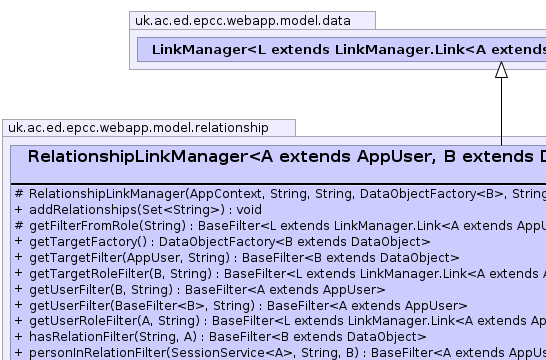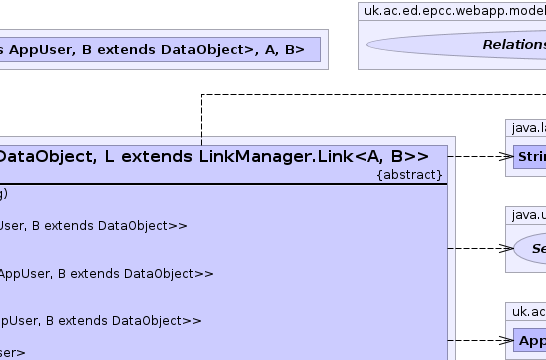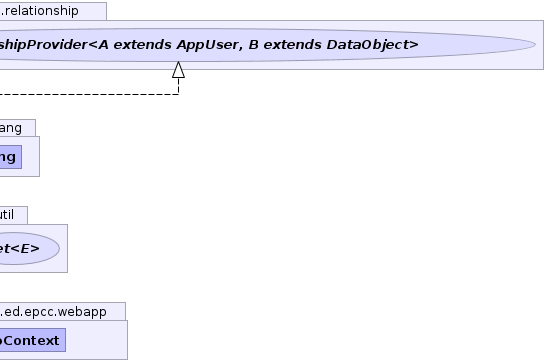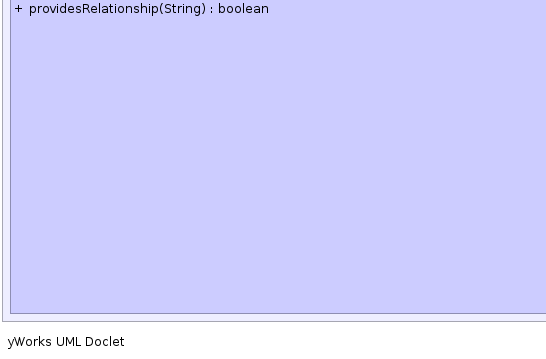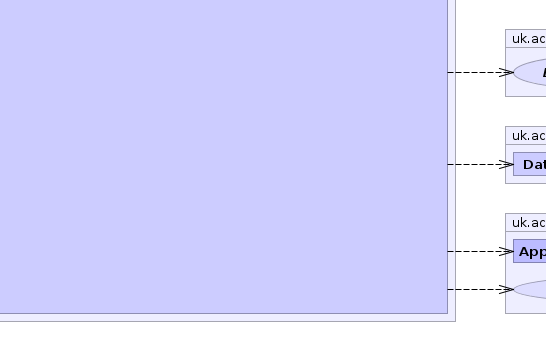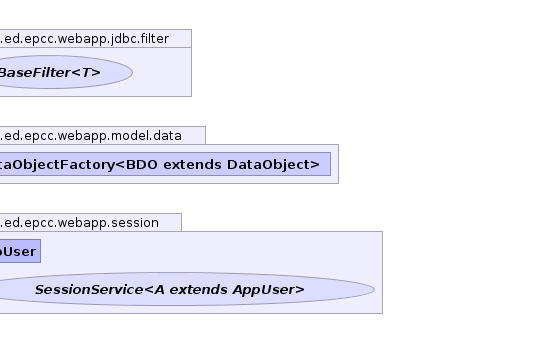- java.lang.Object
-
- uk.ac.ed.epcc.webapp.model.data.DataObjectFactory<T>
-
- uk.ac.ed.epcc.webapp.model.data.IndexedLinkManager<T,L,R>
-
- uk.ac.ed.epcc.webapp.model.data.LinkManager<L,A,B>
-
- uk.ac.ed.epcc.webapp.model.relationship.RelationshipLinkManager<A,B,L>
-
- Type Parameters:
A-B-L-
- All Implemented Interfaces:
- Contexed, ContextCached, FormCreatorProducer, FormUpdateProducer<L>, FilterMatcher<L>, TypeConverter<L,java.lang.Number>, DataObjectSelector<L>, Selector<DataObjectItemInput<L>>, Owner<L>, IndexedProducer<L>, AccessRoleProvider<A,B>, RelationshipProvider<A,B>, Tagged, Targetted<L>
- Direct Known Subclasses:
- AbstractRelationship
public abstract class RelationshipLinkManager<A extends AppUser,B extends DataObject,L extends LinkManager.Link<A,B>> extends LinkManager<L,A,B> implements RelationshipProvider<A,B>
A base class forLinkManagers that implementRelationshipProvider.
-
-
Nested Class Summary
-
Nested classes/interfaces inherited from class uk.ac.ed.epcc.webapp.model.data.LinkManager
LinkManager.JoinLinkFilterIterator, LinkManager.JoinLinkMapper, LinkManager.LeftAcceptFilter, LinkManager.Link<L extends DataObject,R extends DataObject>, LinkManager.LinkInput, LinkManager.LinkResult, LinkManager.RightAcceptFilter
-
Nested classes/interfaces inherited from class uk.ac.ed.epcc.webapp.model.data.IndexedLinkManager
IndexedLinkManager.LinkFilter, IndexedLinkManager.LinkProvider<T extends IndexedLinkManager.Link<L,R>,L extends Indexed,R extends Indexed>, IndexedLinkManager.LinkUpdater, IndexedLinkManager.SQLLinkFilter
-
Nested classes/interfaces inherited from class uk.ac.ed.epcc.webapp.model.data.DataObjectFactory
DataObjectFactory.AbstractDataObjectInput, DataObjectFactory.AbstractFinder<X>, DataObjectFactory.DataObjectAcceptFilter, DataObjectFactory.DataObjectInput, DataObjectFactory.DataObjectIntegerInput, DataObjectFactory.DestAcceptFilter<T extends DataObject>, DataObjectFactory.FilterAdapter, DataObjectFactory.FilterCounter, DataObjectFactory.FilterExists, DataObjectFactory.FilterIterator, DataObjectFactory.FilterSelector, DataObjectFactory.FilterSet, DataObjectFactory.Finder, DataObjectFactory.MakeRemoteFilterVisitor<R extends DataObject>, DataObjectFactory.MatchFilter, DataObjectFactory.ReferencedAdapter<I extends Indexed>, DataObjectFactory.ReferenceIterator<I extends Indexed>, DataObjectFactory.SortingDataObjectInput, DataObjectFactory.TimeAcceptFilter<T extends DataObject>, DataObjectFactory.TimeFilter
-
-
Field Summary
-
Fields inherited from class uk.ac.ed.epcc.webapp.model.data.LinkManager
USE_JOIN
-
Fields inherited from class uk.ac.ed.epcc.webapp.model.data.DataObjectFactory
AUTO_CREATE_TABLES_FEATURE, COMPOSITES_SUFFIX, REJECT_MULTIPLE_RESULT_FEATURE, res
-
-
Constructor Summary
Constructors Modifier Constructor and Description protectedRelationshipLinkManager(AppContext c, java.lang.String tag, java.lang.String person_field, DataObjectFactory<B> b_fac, java.lang.String field)
-
Method Summary
All Methods Instance Methods Abstract Methods Concrete Methods Modifier and Type Method and Description voidaddRelationships(java.util.Set<java.lang.String> roles)Add known roles to a set.protected abstract BaseFilter<L>getFilterFromRole(java.lang.String role)get a filter corresponding to the role.DataObjectFactory<B>getTargetFactory()Get the factory for the target object.BaseFilter<B>getTargetFilter(AppUser user, java.lang.String role)BaseFilter<L>getTargetRoleFilter(B target, java.lang.String role)BaseFilter<A>getUserFilter(BaseFilter<B> fil, java.lang.String role)BaseFilter<A>getUserFilter(B target, java.lang.String role)BaseFilter<L>getUserRoleFilter(A user, java.lang.String role)BaseFilter<B>hasRelationFilter(java.lang.String role, A user)Get aBaseFiltercorresponding to target objects where the given user has the specified relation.BaseFilter<A>personInRelationFilter(SessionService<A> sess, java.lang.String role, B target)Get aBaseFilterforAppUsers that are in the specified relationship with the target object.booleanprovidesRelationship(java.lang.String role)Does this class provide the named relationship.-
Methods inherited from class uk.ac.ed.epcc.webapp.model.data.LinkManager
find, find, getDefaultTableSpecification, getFilter, getFilterResult, getInput, getLeftFactory, getLeftFilter, getLeftFilter, getLeftInput, getLeftJoinFilter, getLeftRemoteFilter, getLinkCount, getLinkIterator, getRightFactory, getRightFilter, getRightFilter, getRightInput, getRightJoinFilter, getRightRemoteFilter, getSelectors, getTarget, isLeft, isRight
-
Methods inherited from class uk.ac.ed.epcc.webapp.model.data.IndexedLinkManager
addLeftSet, addRightSet, getDefaultTableSpecification, getFinalTableSpecification, getFormUpdate, getHistoryHandler, getLeftField, getLeftFilter, getLeftProducer, getLeftSet, getLink, getRightField, getRightFilter, getRightProducer, getRightSet, getTableSpecification, makeHistoryHandler, makeLink, modifyHistoryTable, selectLink, setContext, setHistoryHandler, updateHistory, useAutoHistory
-
Methods inherited from class uk.ac.ed.epcc.webapp.model.data.DataObjectFactory
all, allowPreSelect, canCreate, canUpdate, checkComposite, convertToDestinationFilter, customiseForm, equals, exists, find, find, find, find, find, getAllIterator, getComposite, getComposites, getComposites, getConfigTag, getContext, getCount, getDefaultRelationshipFilter, getDefaults, getDestFilter, getExcludeFilter, getFieldConstraints, getFieldHelp, getFilter, getFilter, getFilter, getFinalSelectFilter, getFinalTableSpecification, getFindFilter, getFormCreator, getID, getIndex, getInput, getInput, getLogger, getMaxIdentifierLength, getNullable, getOptional, getOrder, getProperty, getReferenced, getReferenceFieldType, getReferenceFieldType, getRemoteFilter, getRemoteSQLFilter, getResult, getResult, getSelectFilter, getSelector, getSelector, getSupress, getTableStructureContributers, getTag, getTranslations, getUniqueIdName, hasComposite, hashCode, isMine, isMine, isMyReference, isValid, makeBDO, makeBDO, makeObject, makeRecord, makeReference, makeReference, matches, narrowSelector, narrowSelector, observeComposite, OrderBy, postCreateTableSetup, postSetContext, release, restrictDefaultInput, setComposites, setContext, setContext, setContextWithMake, setProperty, toString, updateTable
-
Methods inherited from class java.lang.Object
clone, finalize, getClass, notify, notifyAll, wait, wait, wait
-
Methods inherited from interface uk.ac.ed.epcc.webapp.model.relationship.RelationshipProvider
getRelationships
-
Methods inherited from interface uk.ac.ed.epcc.webapp.Contexed
getContext
-
-
-
-
Constructor Detail
-
RelationshipLinkManager
protected RelationshipLinkManager(AppContext c, java.lang.String tag, java.lang.String person_field, DataObjectFactory<B> b_fac, java.lang.String field)
-
-
Method Detail
-
getUserRoleFilter
public final BaseFilter<L> getUserRoleFilter(A user, java.lang.String role) throws UnknownRelationshipException
- Throws:
UnknownRelationshipException
-
getFilterFromRole
protected abstract BaseFilter<L> getFilterFromRole(java.lang.String role) throws UnknownRelationshipException
get a filter corresponding to the role.- Parameters:
role-- Returns:
- Throws:
UnknownRelationshipException
-
getTargetRoleFilter
public final BaseFilter<L> getTargetRoleFilter(B target, java.lang.String role) throws UnknownRelationshipException
- Throws:
UnknownRelationshipException
-
getTargetFilter
public final BaseFilter<B> getTargetFilter(AppUser user, java.lang.String role) throws UnknownRelationshipException
- Throws:
UnknownRelationshipException
-
getUserFilter
public final BaseFilter<A> getUserFilter(B target, java.lang.String role) throws UnknownRelationshipException
- Throws:
UnknownRelationshipException
-
getUserFilter
public final BaseFilter<A> getUserFilter(BaseFilter<B> fil, java.lang.String role) throws UnknownRelationshipException
- Throws:
UnknownRelationshipException
-
getTargetFactory
public final DataObjectFactory<B> getTargetFactory()
Description copied from interface:RelationshipProviderGet the factory for the target object.- Specified by:
getTargetFactoryin interfaceRelationshipProvider<A extends AppUser,B extends DataObject>- Returns:
DataObjectFactory
-
hasRelationFilter
public final BaseFilter<B> hasRelationFilter(java.lang.String role, A user)
Description copied from interface:AccessRoleProviderGet aBaseFiltercorresponding to target objects where the given user has the specified relation. If the method returns null then the role is not recognised by the provider. A non-null result means the role is recognised but does not imply that any target will match. The relation with a specific target object can be tested usingDataObjectFactory.matches(BaseFilter, DataObject)This method should not be called directly only via a call toSessionService.getRelationshipRoleFilter(DataObjectFactory, String)to allow theSessionServiceto combine and customise access rules.- Specified by:
hasRelationFilterin interfaceAccessRoleProvider<A extends AppUser,B extends DataObject>- Returns:
BaseFilteror null
-
personInRelationFilter
public final BaseFilter<A> personInRelationFilter(SessionService<A> sess, java.lang.String role, B target)
Description copied from interface:AccessRoleProviderGet aBaseFilterforAppUsers that are in the specified relationship with the target object. This is the inverse of#hasRelationFilter(SessionService, String)used to generate a list ofAppUserwith the relation. It can always be implemented (inefficiently) by creating anAcceptFilterthat usesAccessRoleProvider.hasRelationFilter(String, AppUser)to check each person in turn but though it is usually possible to find someSQLFilterto narrow the selection first even if a full SQL implementation is not possible. If the target is null it should generate a filter for any user in relation with targets selected byDataObjectFactory.getDefaultRelationshipFilter(). If this is not possible it should return null;- Specified by:
personInRelationFilterin interfaceAccessRoleProvider<A extends AppUser,B extends DataObject>- Returns:
BaseFilteror null
-
providesRelationship
public final boolean providesRelationship(java.lang.String role)
Description copied from interface:AccessRoleProviderDoes this class provide the named relationship.- Specified by:
providesRelationshipin interfaceAccessRoleProvider<A extends AppUser,B extends DataObject>- Returns:
- true if relationship provided by this class.
-
addRelationships
public final void addRelationships(java.util.Set<java.lang.String> roles)
Description copied from interface:AccessRoleProviderAdd known roles to a set. This can be roles provided or consumed by the class. This is only used as auto-complete suggestions so should be a useful subset rather than an exhaustive list- Specified by:
addRelationshipsin interfaceAccessRoleProvider<A extends AppUser,B extends DataObject>
-
-
